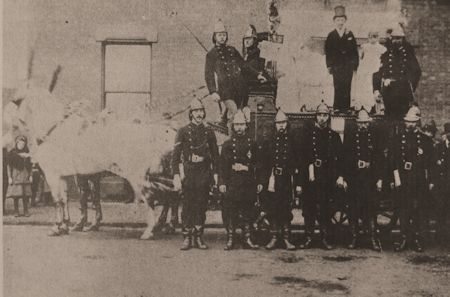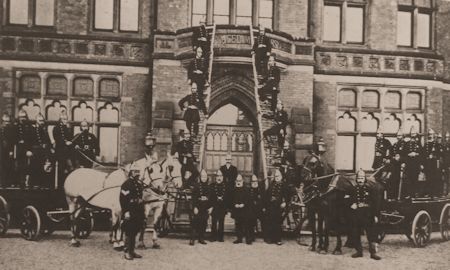The Dark Town Brigade was the name they gave Wallasey’s first fire-fighting service. Part-time, volunteer, and poor in equipment. A brigade that began with a hardcart and a ladder, and that had to go to a cottage to collect the key to a ‘station’ that was little more than a shed. A brigade that was to become enough and brave enough to take on the worst in fire and terror that bombs could shower down in war. The pioneer ‘Dark Town’ men started a great tradition.
The brigade was voluntary up to about 1900. The men drew a small retaining fee. The town’s first fire station stood on a site fronting Mill Lane Water Tower. It housed one hardcart and a leather reel the only one in Wallasey. There was a scaling ladder or two, some stand pipes, and a 40-foot escape. Smith’s Cottage, in the vicinity of the corner of Dinmore Road, was where the station key was kept. A Captain Leader, outdoor head of the local water department, was the chief officer.
The firemen practised every Saturday afternoon. The bell rang. They all rushed out. The local children regarded the whole thing as enormous fun. And so, it was said, did certain of the firemen.
A wagon was acquired in the 1890s, and Messrs. Gibbons, of Liscard, provided the horses to draw it. The stables were on the old site of the Capitol Cinema, corner of Seaview Road and Liscard Village. Branches of the brigade were formed in Seacombe, under a tobacconist named John Howarth, of Brighton Street, and in Wallasey Village, under a water inspector, named Abraham Halewood.
Arrangements for calling the men and their equipment out where somewhat vague. The ‘Dark Town Brigade’ deserved its nickname. In due course a building was erected on a site at the bottom of Manor Road at the Liscard Village end. There was stabling and a yard.
Equipment grew, and included a manual fire engine, long ladders, and more up-to-date hoses. The engine was last used at a fire at new Brighton Tower in 1898. In that particular blaze a Fireman Shone lost his life.
The Tower, 621 feet high, had just been completed and opened to the public. The young fireman, a volunteer from Seacombe, fell 90 feet while fighting a blaze among the girders. Shortly after the tragedy moves were made to put the brigade on a more efficient footing. A growing town realised that it needed a better fire service.
For the first time a full time paid superintendent and a full-time engineer were appointed to control the nine auxiliaries who were available to be called out.
The station in Liscard was extended to include a duty room and a new house for the steam engine. A summons bell was put on the top of the station. In later years it was used to signal closing time for Central Park. There was a horse-drawn chemical engine, with a 60-gallon cylinder. The brigade took on its strength an ambulance, which up to that time had been operated from Gibbon’s in Liscard.
 |
Wallasey firemen ready for a MAy Day parade in the early early of the twentieth century. The horses are decorated with flowers. A top-hatted gentleman stands on the engine. |
A fire sub-station was established in Platt Street, Seacombe, where Messrs. Kenna’s supplied the horses.
1912 saw the arrival of two motor engines, one fitted with a 60-foot extension ladder, the other with a wheeled escape.
More men were appointed on a permanent basis, and loan sanction was obtained for the Central Station that once stood in Liscard.
In 1914 the brigade was taken over by the police administration. On October 23rd of that year the Liscard station, with its 58-foot tower, was formally opened.
The establishment of a proper fire service came at a time Wallasey was becoming a bustling township, when the scattered ‘villages’ of Seacombe, Poulton and New Brighton were being wielded into a borough of importance. The service was really put to the test in the 1920s. There were several big fires in the town.
The worst was the vast blaze that gutted the Gandy Belt works in Seacombe in February, 1927. In 1931 came the fire that destroyed the old Lyceum Cinema in King Street. It had originally been a church. Later it became the Unit 6 and today the site is occupied by flats.
At the outbreak of war in 1939, 400 members of the Auxiliary Fire Service were enrolled as full-time firemen and in August 1914, all fire services were nationalised to make the most efficient use of men and material to combat fires caused by enemy action.
In the long, dark months of the air raids that came in 1940 and 1941 the Wallasey brigade wrote the proudest chapter in its long story.
Aided by the waters of the Mersey and the Dee glistening in the moonlight, German bombers visited Merseyside time and again, dropping incendiaries to light a beacon target for the high explosives carried by heavier aircraft following on. The first bombs fell on Wallasey on August 19thm 1940. The long ordeal had started. Between August, 1940, and January, 1942, there were over 500 alerts.
In addition to 340 townspeople killed, 275 were seriously injured. The town was brutally battered night after night. In the raids, over 650 high explosives were dropped on it, over 1,000 houses destroyed, and over 17,000 houses damaged. Fires raged everywhere. There were weeks when the fire-fighters went almost completely sleepless.
With the other Civil Defence workers, and with the families in the dimly-lit shelters, they took an excursion into hell.
In the blackest period of the blitz, in March, 1941, the water supply failed. It was the grimmest moment of Wallasey’s war. But the fire and A.R.P. services kept themselves alive. They went on working. They won through.
The fire brigade came under local control again in April, 1948. It harnessed all the new fire-fighting aids, completely modernising itself.
 |
Horse-drawn engines and push-it-up-ladders. A cameraman c1905 got the firemen to pose outside the Mariners' Home, Egremont. |
Featured sites
- Non Gamstop Casinos
- Casino Not On Gamstop
- UK Casinos Not On Gamstop
- Non Gamstop Casinos UK
- Sites Not On Gamstop
- Sites Not On Gamstop
- Casinos Not On Gamstop
- Casinos Not On Gamstop
- Casinos Not On Gamstop
- Non Gamstop Casino UK
- Casinos Not On Gamstop
- Non Gamstop Casino
- UK Online Casinos Not On Gamstop
- UK Online Casinos Not On Gamstop
- Non Gamstop Casinos
- Casino Sites Not On Gamstop
- Casinos Not On Gamstop
- Casinos Not On Gamstop
- Best Betting Sites
- Casinos Not On Gamstop
- Gambling Sites Not On Gamstop
- Betting Sites That Are Not On Gamstop
- Non Gamstop Casinos UK
- UK Online Casinos Not On Gamstop